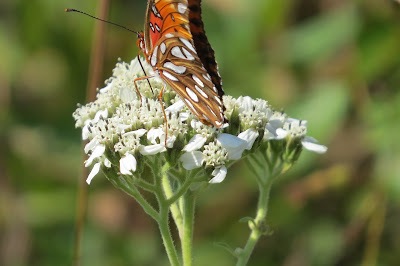Tuesday September 26th
Today I was able to step onto the Appalachian Trail.

I've walked sections of the trail in my younger days. Been on the AT in Shenandoah Valley National Park, The Delaware Water Gap and in Eastern Tennessee. And today I've returned to the Tennessee-North Carolina border.
The trail crosses the Balds of Roan Mountain and can be accessed at Carver's Gap in the Cherokee National Forest. The attraction for birders to visit here is that the high elevations in the Southern Appalachians features eco-systems more commonly found in more northerly latitudes. Above 5000 feet of elevation the eco-system can be described as the

Canadian Zone. Birders, visiting in September, can be treated to Juncos, Red-breasted Nuthatches, Ravens and Kinglets, plus migrating songbirds and raptors passing through the Gap.
Northern Saw-whet Owls can be found (heard) here in early summer.
As the elevations rise, from entering the Roan Mountain State Park to the summit, the variety of birdlife changes.
See
Tennessee Watchable Wildlife web site for a excellent description on when and were to locate birds of interest on Roan Mountain. June is probably the best time of year to do some birding for species like nesting Golden-winged Warblers, Adler and Willow Flycatchers and the Northern Saw-whet Owl. Hopefully I can return next June.
 |
The Trail up Roan Mountain
|
 |
| Juncos were very common atop Roan Mountain |
Hiked to the top of the Bald from Carver's Gap and encountered a few of those resident northern species such as Common Raven, Dark-eyed Juncos, Red-breasted Nuthatches, Eastern Towhee and Golden-crowned Kinglets.
Migrants were strikingly absent today. Only encountered a sole Chimney Swift, a single Broad-winged Hawk, several Ruby-crowned Kinglets, a couple of Blue-headed Vireos and a couple of Palm Warblers.
 |
A View from Atop the Round Bald on Roan Mountain
|
 |
A View from Carver's Gap
|
|
|
| Roan Mountain Visitor Center |
Roan Mountain State Park
Took some time in the afternoon to do some additional birding in the
state park. Not much in the way of any migrants, but did find
Eastern Phoebe, Carolina Chickadees, Carolina Wrens, American Robin, Gray Catbird, Tufted Titmice, American Crow, Blue-headed Vireo and Downy Woodpecker.
 |
In 1870, General John T Wilder purchased this property and would establish the Peg Leg Mine.
Used a similar water Wheel, along the Doe River, to crush the mined iron ore
|
Sycamore Shoals State Historic Park
 |
| Reconstructed Fort Watauga at Sycamore Shoals |
Made a final stop for the day at
Sycamore Shoals State Park in nearby Elizabethton, Tennessee. The park is the sight for the reconstruction of Fort Watauga where local patriot militias, known as the '
Overmoutian Men' assembled to defend against British troops in the American Revolution. They would meet the British later on Kings Mountain, North Carolina for a short but bloody victory.
Again the birding wasn't that great but did add
Canada Geese and a
Song Sparrow down at the Watauga River
 |
| Canada Goose |






















































